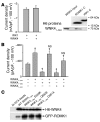Intersectin links WNK kinases to endocytosis of ROMK1
- PMID: 17380208
- PMCID: PMC1821066
- DOI: 10.1172/JCI30087
Intersectin links WNK kinases to endocytosis of ROMK1
Abstract
With-no-lysine (WNK) kinases are a novel family of protein kinases characterized by an atypical placement of the catalytic lysine. Mutations of 2 family members, WNK1 and WNK4, cause pseudohypoaldosteronism type 2 (PHA2), an autosomal-dominant disease characterized by hypertension and hyperkalemia. WNK1 and WNK4 stimulate clathrin-dependent endocytosis of renal outer medullar potassium 1 (ROMK1), and PHA2-causing mutations of WNK4 increase the endocytosis. How WNKs stimulate endocytosis of ROMK1 and how mutations of WNK4 increase the endocytosis are unknown. Intersectin (ITSN) is a multimodular endocytic scaffold protein. Here we show that WNK1 and WNK4 interacted with ITSN and that the interactions were crucial for stimulation of endocytosis of ROMK1 by WNKs. The stimulation of endocytosis of ROMK1 by WNK1 and WNK4 required specific proline-rich motifs of WNKs, but did not require their kinase activity. WNK4 interacted with ROMK1 as well as with ITSN. Disease-causing WNK4 mutations enhanced interactions of WNK4 with ITSN and ROMK1, leading to increased endocytosis of ROMK1. These results provide a molecular mechanism for stimulation of endocytosis of ROMK1 by WNK kinases.
Figures








References
-
- Xu B., et al. WNK1, a novel mammalian serine/threonine protein kinase lacking the catalytic lysine in subdomain II. J. Biol. Chem. 2000;275:16795–16801. - PubMed
-
- Verissimo F., Jordan P. WNK kinases, a novel protein kinase subfamily in multi–cellular organisms. Oncogene. 2001;20:5562–5569. - PubMed
-
- Wilson F.H., et al. Human hypertension caused by mutations in WNK kinases. Science. 2001;293:1107–1112. - PubMed
-
- Gordon R.D. Syndrome of hypertension and hyperkalemia with normal glomerular filtration rate. Hypertension. 1986;8:93–102. - PubMed
Publication types
MeSH terms
Substances
Grants and funding
LinkOut - more resources
Full Text Sources
Other Literature Sources

